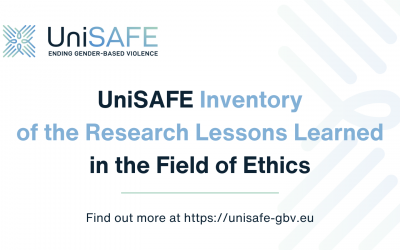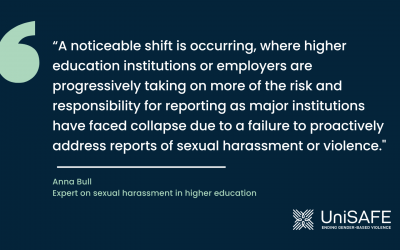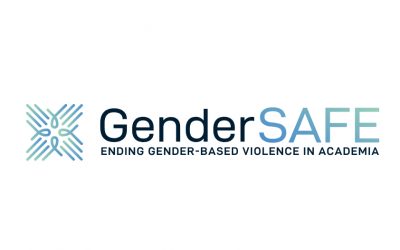This policy brief, published by the UniSAFE project in November 2022, focuses on the results from the project’s first research period with the aim to inform policy makers on the state-of-the-art on gender-based violence in academia and research.
The brief summarises the project findings on gender-based violence (GBV) in higher education and research through the mapping of policies and measures on gender-based violence in European universities and research organisations and the conduction of a survey to collect measurable evidence on the prevalence of gender-based violencein academia and research.
Survey results
Between January and May 2022, UniSAFE conducted the largest survey so far on GBV in academia in the European Research Area, with over 42,000 responses.
Nearly two in three (62%) of the respondents who took part in the UniSAFE survey disclosed having experienced at least one form of gender-based violence since they started working or studying at their institution. Almost 1 in 3 respondents have experienced sexual harassment.
Main findings on prevalence of GBV in academia
Based on respondents’ experience within their institution (since starting there)
- Students vs staff: students less affected by gender-based violence overall, though more at risk of physical and sexual violence
- Gender identity: women most at risk of sexual violence and sexual harassment; men most at risk of physical violence; non-binary people most at risk of sexual harassment, psychological violence and economic violence
- Trans: trans people more affected by psychological violence and sexual harassment
- Sexual orientation: increased exposure to gender-based violence among homosexual, bisexual or queer people
- Disability: all forms of gender-based violence more prevalent among people with a disability or chronic illness
- Minority ethnic status: higher prevalence of all forms of gender-based violence among people from a minority ethnic group
- International status: international staff/students at higher risk of economic violence and sexual violence
- Academic vs non-academic staff: lower prevalence of most forms of gender-based violence among non-academic staff
- Contract type: higher levels of gender-based violence among staff on permanent contracts
- Working hours: being on full-time contracted hours of work associated with higher prevalence of gender-based violence
- Academic grades: higher prevalence of gender-based violence overall among higher grades, as well as of psychological violence and sexual harassment
- Study level: doctoral candidates more at risk of gender-based violence overall, and particularly economic violence
- Campus residence: living on campus associated with greater prevalence of gender-based violence overall, particularly sexual violence, sexual harassment, and physical violence
Policy implications and recommendations
Gender-based violence is perceived as an issue by 72% of respondents but only 36% are aware of policies in place at their institution.
This puts the spotlight on the need for awareness-raising actions and on the gap between the seriousness of the issue and actions taken at the institutional level on the issue of gender-based violence.
Institutional policies tend to be the most comprehensive in countries where the national policy framework is the strongest (Spain, Ireland, France)
National authorities should be encouraged to adopt framework policies for their higher education and research sector to ensure that RPOs take action to end gender-based violence.
Marked differences exist between the EU14[1] and EU13 Member StatesEU13 policies are briefer, and there are very few in place at the national level compared to the EU14.
National authorities and RPOs in EU13 should step up their actions to address gender-based violence to ensure safe and respectful study and work environments appropriate for the common European Higher Education and Research Areas.
The survey results highlight a high degree of uncertainty among the victims and survivors of what constitutes a serious issue and even to identify acts as violent.
This underlies the importance of preventive measures and particularly of trainings, induction sessions and awareness-raising campaigns.
While people understand and on an attitudinal level assume responsibility for intervening when incidents happen, the actual rate of intervention is very low with 74% never intervening when witnessing an incident.
This may indicate uncertainty about stepping in. This further reinforces the need for preventative awareness raising and trainings and concrete actions aimed at bystanders.
[1] The EU14 are the EU Member States that joined the EU before 2004, without the UK, which left the EU in 2020: Austria, Belgium, Denmark, Finland, France, Germany, Greece, Ireland, Italy, Luxembourg, Netherlands, Portugal, Spain, and Sweden.



